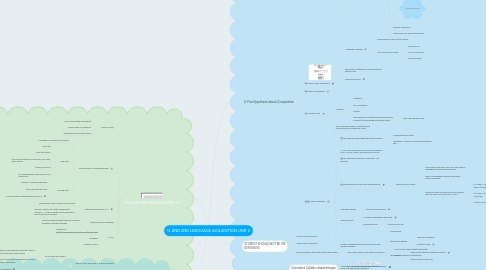
1. B. The causative variable in Second Language Acquisition
1.1. Factors
1.1.1. Instruction=Language Teaching
1.1.1.1. When language teaching helps
1.1.1.1.1. Classromm usefull for beginners
1.1.1.1.2. Foreign Language Situation
1.1.2. Exposure to Second Language
1.1.3. Age of adquirer
1.2. Schumann's acculturation hypothesis
2. True Causes are:
2.1. ComprehendED INPUT
2.2. Streght of the Filter
3. PROVIDING INPUT FOR ACQUISITION
3.1. Input for Adult
3.1.1. More complicated gramatically
3.1.2. Wider range of vocabulary
3.1.3. Deals with more complex topics
3.2. Optimal Input is Comprenhensible
3.2.1. Language is directed to the learner
3.2.2. Linguistic
3.2.2.1. Slow rate
3.2.2.2. Clear articulation
3.2.2.3. Use of high frequency vocabulary, less slang, fewer idioms
3.2.2.4. Shoter sentences
3.2.2.5. Do comprehension checking ¿Do you undestand?
3.2.3. Non linguistic
3.2.3.1. Support of realia and pictures
3.2.3.2. Use of the here and now
3.2.3.3. Use the student kmowledge of the world
3.3. Optimal input included i + 1
3.3.1. ir guarantees natural review and recycling
3.3.2. Warning: There is no need to deliberately include i + 1, if the meaning can be negotiated. then it will occur naturally
3.4. Optimal Input is Interesting
3.4.1. Make the student forget that the message is encoded in another language
3.5. AVOID
3.5.1. Pattern Drill http://www.dictionary.com/browse/pattern-drill
3.5.2. Dialogues
3.5.3. Meaning full Drill
3.6. Optimal Input should be in suficient quantity
3.6.1. To end the silent period
3.6.1.1. Child second language acquisition takes 6 month to end the silent period
3.6.1.2. 10 hours of Total Physical Response is enough to end the silent period
3.6.2. FSI 2+ ->Halfway between Minimal and working professional proficiency
3.6.2.1. European Languages= 720 h of classtime
3.6.2.2. Exotic Languages=1980 h of classtime
4. Gramatical Syllabus disadvantages
4.1. All students may not be at the same *stage* i
4.2. Each structure is presented only once
5. A. Five Hypothesis about L2 acquisition
5.1. Language Acquisition Distintions
5.1.1. Language Acquisition (Picking up the Language)
5.1.1.1. Implicit Learning
5.1.1.2. Informal Learning
5.1.1.3. Natural Learning
5.1.1.4. Initiates Utterances
5.1.1.5. Responsible for fluency/production
5.1.2. Language Learning
5.1.2.1. Responsible for the Monitor/ Editor
5.1.2.2. User can use rules when
5.1.2.2.1. There is time
5.1.2.2.2. Focus on the from
5.1.2.2.3. Rules is known
5.2. Natural Order Hypothesis
5.2.1. WE should not attempt to teach along the natural order
5.2.2. Transitional Forms
5.3. Monitor Hypothesis
5.4. Affective Filter
5.4.1. Variables
5.4.1.1. Motivation
5.4.1.2. Self-confidence
5.4.1.3. Anxiety
5.4.1.4. This variable will impede/interfere the delivery of input to the language acquisition device
5.4.1.4.1. Thus filter should be low
5.4.2. We as a teacher need to create learning situation that encourage low filters
5.5. Imput Hypothesis
5.5.1. The acquirer understands input that contains i +1
5.5.1.1. !Comprehensible Input!
5.5.1.2. Acquisition requires a comparison between i and 1
5.5.2. IT SAYS we acquired by an GOING for meaning FIRST, and as a result, we acquired structure.
5.5.3. This hypothesis relates to acquisition, not learning
5.5.4. Speaking fluency cannot be taught directly
5.5.4.1. There is a silent period
5.5.4.1.1. In this period acquirers does not used creative language but memorized sentences
5.5.4.1.2. When real language emerge is with short simple sentences
5.5.4.1.3. Performers that are asked to produce before they are ready will fall back in L1 rules
5.5.5. Caretaker speech
5.5.5.1. Here and now principle
5.5.6. Adult teaching
5.5.6.1. Use their knowlodge of the world
5.5.6.2. Pedagogical aids
5.5.6.2.1. Pictures and realia
5.5.7. Method comparison experiments back up the input hypothesis
5.5.7.1. AudioLingual
5.5.7.2. Deductive Methods
5.5.7.2.1. Grammar Translation
5.5.7.2.2. Cognitive code
5.5.7.3. Input-Based
5.5.7.3.1. Asher's Total Physical Response Method
5.5.7.3.2. Terrell's Natural Approach
5.5.8. Classroom is an excellent place for 2L ACQ, at least up to the intermediate level
6. STUDENT SHOULD NOT BE ON DEFENSIVE
6.1. Not to force production
6.2. Flaws of error correction
6.3. Provide students with tools to help them obtain
6.3.1. Teach them how to deal with conversation
6.3.1.1. How to start conversation (greetings)
6.3.1.2. How to maintain conversations
